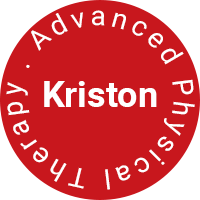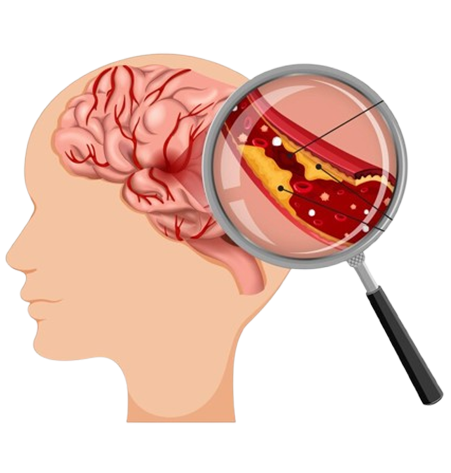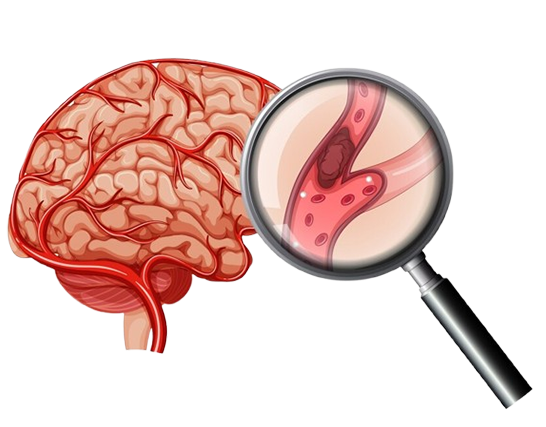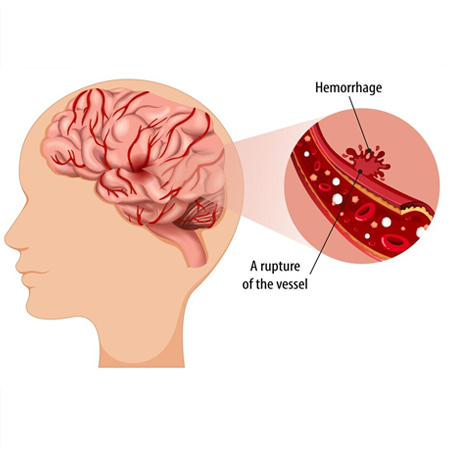Atherosclerosis Stroke
Plaque buildup gradually narrows arteries, severely restricting blood flow and significantly increasing stroke risk over time.
A stroke occurs when blood flow to the brain is interrupted, leading to potential brain damage. It can result from a blocked artery (ischemic stroke) or a burst blood vessel (hemorrhagic stroke). Common symptoms include sudden numbness, confusion, vision problems, and loss of coordination. Immediate medical attention is crucial to minimize damage and improve recovery outcomes. Rehabilitation focuses on restoring mobility, speech, and cognitive function through therapy and lifestyle changes. Preventing strokes involves managing blood pressure, maintaining a healthy diet, and staying physically active. With prompt treatment and proper care, stroke survivors can regain independence and improve their quality of life. Recognizing early warning signs can save lives and reduce long-term complications.


Plaque buildup gradually narrows arteries, severely restricting blood flow and significantly increasing stroke risk over time.
A blood clot blocks oxygen supply to the brain, potentially causing lasting damage and neurological complications.
A ruptured blood vessel unexpectedly causes severe brain bleeding, often due to uncontrolled high blood pressure or a dangerous aneurysm.
Atherosclerosis stroke occurs when plaque buildup narrows or blocks arteries, reducing blood flow to the brain. Over time, fatty deposits, cholesterol, and other substances accumulate, leading to artery hardening and increasing the risk of stroke. This condition can cause transient ischemic attacks (TIAs) or full strokes, resulting in brain damage, impaired mobility, and cognitive issues. Risk factors include high blood pressure, smoking, diabetes, and poor diet. Preventive measures such as a healthy lifestyle, medication, and medical interventions like angioplasty help manage the condition. Early diagnosis and proactive treatment significantly reduce stroke risk and improve long-term health. Regular checkups, exercise, and balanced nutrition are essential for maintaining vascular health and preventing complications.

Immediate medical attention minimizes brain damage and improves recovery chances.
Physical, occupational, and speech therapy help restore mobility, function, and communication.
Blood thinners, clot-busting drugs, and blood pressure control reduce further stroke risks.
Healthy diet, regular exercise, and quitting smoking support long-term recovery and prevention.

Begin your journey to recovery with expert care, personalized treatments, and proven therapies for a healthier, stronger future.

Hemorrhagic stroke occurs when a blood vessel in the brain bursts, causing bleeding that damages surrounding tissues. This can result from high blood pressure, aneurysms, or trauma. Symptoms include sudden severe headaches, vision problems, weakness, and confusion. Immediate medical attention is crucial to minimize brain damage and improve outcomes. Treatments focus on stopping the bleeding, reducing pressure, and preventing complications. Rehabilitation, including physical and speech therapy, helps regain lost functions and restore quality of life. Adopting a healthy lifestyle with blood pressure control, balanced nutrition, and regular exercise lowers future stroke risk. Early intervention and continuous care are key to better recovery and long-term health.
Strengthens muscles, enhances mobility, and restores independence through targeted exercises and movement.
Improves communication skills, language abilities, and swallowing functions for better daily interactions.
Boosts memory, problem-solving, focus, and mental clarity through structured brain exercises.
Enhances coordination, reduces muscle stiffness, and promotes smoother, more controlled movement patterns.
Sudden numbness, confusion, trouble speaking, vision loss, dizziness, or severe headache require immediate medical attention.
Doctors use CT scans, MRIs, blood tests, and neurological exams to determine stroke type and severity.
Treatments include clot-busting medications, surgery, rehabilitation therapy, and lifestyle changes for long-term recovery.
Yes, maintaining a healthy diet, exercising, controlling blood pressure, and managing diabetes reduce stroke risk significantly.
© All Rights Reserved by Kriston Healthcare